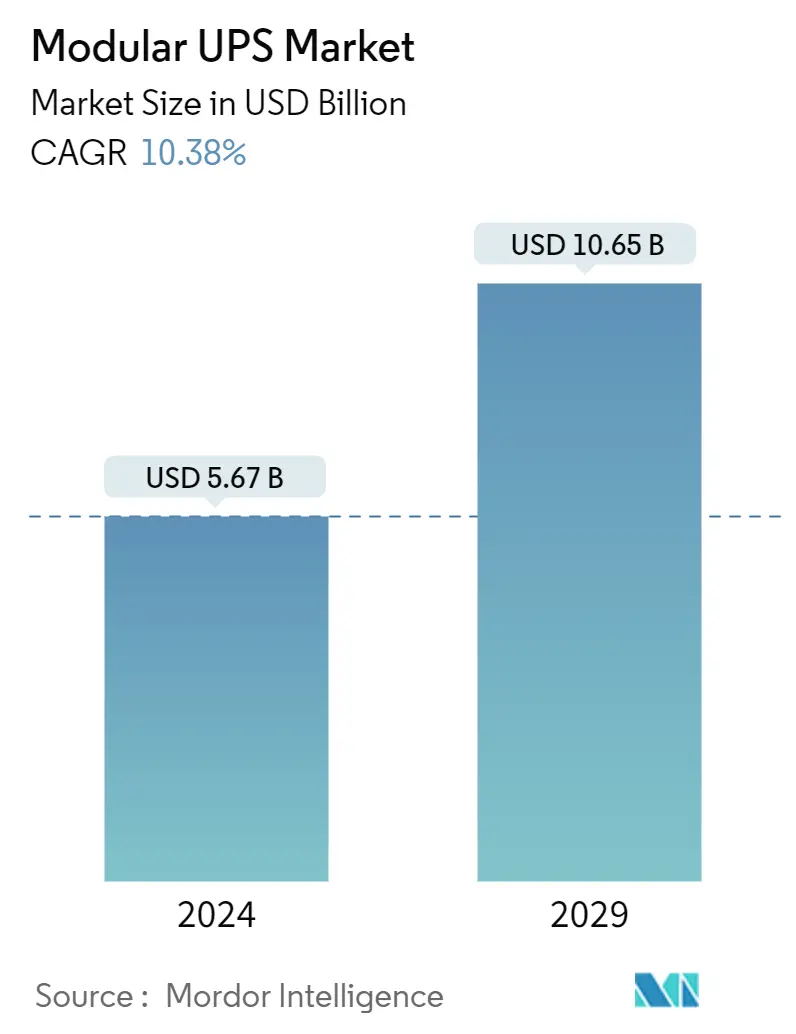Market Size of Modular UPS Industry

| Study Period | 2019-2029 |
| Market Size (2024) | USD 5.67 Billion |
| Market Size (2029) | USD 10.65 Billion |
| CAGR (2024 - 2029) | 10.38 % |
| Fastest Growing Market | Asia Pacific |
| Largest Market | North America |
Major Players
*Disclaimer: Major Players sorted in no particular order |
Need a report that reflects how COVID-19 has impacted this market and its growth?
Modular UPS Market Analysis
The Modular UPS Market size is estimated at USD 5.67 billion in 2024, and is expected to reach USD 10.65 billion by 2029, growing at a CAGR of 10.38% during the forecast period (2024-2029).
Data losses, lack of key services, hardware risks and significant financial loss may result from power disturbances in data centers that typically require 100% availability. Therefore, in order to ensure continuous power supply and reduce the risk of system failure, there is a high demand for UPSs in data centers. As a result of the growing reliance on large-scale applications and cloud services, demand for colocation services has increased, offering new prospects for the modular UPS industry.
- The modular uninterruptible power supply (UPS) is a resilient and adaptable power protection system that regulates UPS performance. The modules are hot-swappable and automatically recognized when connected. The product's adoption is expected to be strengthened by its robust implementation of zero and dependable power downtime. Modular UPS systems are becoming more prevalent among companies that require a dependable power source for their essential infrastructure.
- There has been a growing demand for new technology advancements, such as cloud computing adoption, data storage needs,digital services, regulatory requirements, expanding user base, and business scalability across regions.
- The primary benefits of a modular uninterruptible power supply (UPS) system lie in its capacity for scalable expansion and decreased maintenance expenses. Hyperscale data centers and colocation providers employ modular UPS technology, employing various architectures to minimize operational costs and maintain redundant capacity. Many organizations opt for smaller modules supporting 10-kilovolt amperes to 50 kVA, as N+1 designs offer cost-effective redundancy, superior loading, and efficiency compared to multiple parallel UPS systems. Meanwhile, 2N designs ensure precise load matching.
- Modular systems offer a simplified and more manageable approach to maintenance. The modules are designed to be hot-swappable, allowing for seamless removal, replacement, and testing while the system remains operational. Modular UPS systems have power capacities ranging from 10-100 kVA, 100-250 kVA, 215 kVA, and 500 kVA and above. These systems are widely utilized in diverse sectors, including data centers, industries, telecommunications, commercial, BFSI, government, and other verticals.
- Moroever, the initial installation expenses associated with modular UPS systems typically exceed those of conventional centralized UPS solutions. Although the modular approach provides scalability and adaptability, the upfront capital investment may dissuade budget-conscious clients, particularly those in smaller enterprises or organizations with limited financial resources.
- The modular uninterruptible power supplyUPS market has been negatively affected by the COVID 19 pandemic. The development of the modular UPS market has been greatly influenced by the closure of large government, energy and industrial undertakings.
